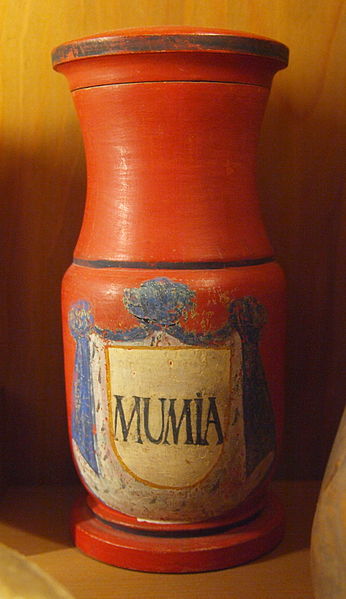Mummia, mumia, or originally mummy referred to several different preparations in the history of medicine, from "mineral pitch" to "powdered human mummies". It originated from Arabic mūmiyā "a type of resinous bitumen found in Western Asia and used curatively" in traditional Islamic medicine, which was translated as pissasphaltus in ancient Greek medicine. In medieval European medicine, mūmiyā "bitumen" was transliterated into Latin as mumia meaning both "a bituminous medicine from Persia" and "mummy". Merchants in apothecaries dispensed expensive mummia bitumen, which was thought to be an effective cure-all for many ailments. It was also used as an aphrodisiac.
Natural asphalt/bitumen from the Dead Sea
Apothecary vessel of the 18th century with inscription MUMIA
Wooden apothecary vessel with inscription "MUMIÆ", Hamburg Museum
A mummy is a dead human or an animal whose soft tissues and organs have been preserved by either intentional or accidental exposure to chemicals, extreme cold, very low humidity, or lack of air, so that the recovered body does not decay further if kept in cool and dry conditions. Some authorities restrict the use of the term to bodies deliberately embalmed with chemicals, but the use of the word to cover accidentally desiccated bodies goes back to at least the early 17th century.
A mummified man likely to be Ramesses I
Howard Carter examining the innermost coffin of Tutankhamun
A 550-year-old Peruvian child mummy being prepared for a CT scan
Mummy in the British Museum







